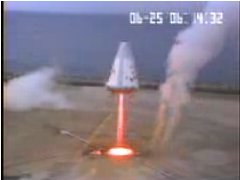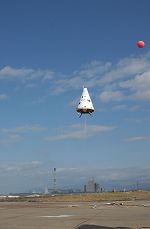Interview*
with Yoshifumi Inatani
Leader
of the Japanese RVT Project
*
via email
|
In Japan a
project little known in the US is successfully following a step-by-step
development route to a fully reusable launch vehicle (RLV). Since
1999 the RVT
(Reusable Vehicle Testing) project has flown to low altitudes
a vertical take-off and landing vehicle powered by a liquid hydrogen/liquid
oxygen engine. The vehicle has undergone three major modifications
in which each new version involved tests of additional components,
systems and techniques needed for practical RLVs. The third configuration
completed a series of test flights in October 2003.
To find out
more about this fascinating project, I contacted its leader Yoshifumi
Inatani. He
is a professor of the space system engineering division at ISAS
(the Institute of Space and Astronautical Science). ISAS is a
university organization
|
|
that was recently combined with NAL
(National Aerospace Laboratory), and NASDA
(the Japanese National Space Development Agency) to form JAXA
(Japanese Aerospace Exploration Agency). ISAS remains, however, an independent
institute within JAXA..
Prof. Inatani generously
agreed to answer a set of questions I sent to him by email. (A second
set of follow-up questions and answers are shown indented.)
Mark Oakley of Rocket
Man Blog contributed some questions on the vehicle design.

Prof. Yoshifumi Inatani
|
|
HS:
Many space advocates in the US look back on the DC-X
project as a huge success and lament the fact that it was not
followed with an incremental, step-by-step development of a series
of vehicles that eventually reached orbit. Instead, NASA jumped
to the X-33
and the failure of that project has discredited SSTO, and RLVs
in general, in the eyes of many here.
It
is great to see that you are in fact following the step-by-step
approach and actually flying single stage rocket VTVL vehicles.
Could
you briefly review the three RVT vehicles flown so far and what
you have learned from each?
Inatani:
: The background idea of our activity is as follows.
ISAS Reusable
Vehicle Testing (RVT) team has been continuously
|
conducting basic studies
and series of flight test. The primary objective of the study is to learn
how to design, build and operate future reusable space transportation
systems. The goal of the future vehicle is to be totally economically
viable by which very frequent flight and mass transportation are possible.
In order to make space tourism and construction of huge orbital space
structures; such as solar power satellite, happen, vehicle system architecture
will be totally different from that of existing expendable launch vehicles.
Taking the system architecture in mind, a series of basic studies has
been conducted. The system that allows in-flight malfunctions and safe
abort, liquid hydrogen rocket propulsion subsystems for repeated flight
which makes quick and safe turnaround possible, potential benefit of use
of composite material for vehicle structure and propulsion subsystems,
integrated propulsion and power systems, aerodynamics and flight mechanics
for rocket propelled vertical landing, and so on are the key elements
to the future vehicles presented above.
Since 1999, the
test vehicle was built and flight-tested, gradually increasing [the]
test and demonstration items and flight articles. The first test campaign
was conducted for qualifying landing operation making use of engine
throttling in 1999. Primarily improving engine durability and landing
guidance, the second flight test was made in 2001. Many parts of the
vehicle were replaced by newly developed articles such as combustion
chamber by electroforming technique, RTK-GPS for landing navigation
and optimized flight guidance for minimum use of fuel and oxidizer for
landing, aero-shell installation for managing aerodynamics, and so on.
As a result, flight envelope was extended and these new articles were
qualified. Since then new challenges; e.g. fuel and oxidizer injector
using electroforming for reducing number of parts and increasing durability,
and composite cryogenic tank for liquid hydrogen, further improvement
in onboard failure detection and safe-landing architecture, were conducted.
Taking these new articles accommodated into the vehicle, the third flight
test campaign (RVT#3) was carried out in October 2003 and completed
three flights as they were planned.
The RVT campaign
is [...] for making maximum use of repeated flight environment, and
various new technical items and challenges presented above have been
studied, developed and flight demonstrated through these study and flight-test
environments. The team realizes that the way of doing things is totally
different from that in the expendable vehicle studies and testing, because
it comes back and does it again. The team has experienced already eight
[flights] altogether, and [a] wide range of design knowledge and exercises
in repeated flight operation have been accumulated from test to test.
The campaign will be continued with conducting more new studies of integrated
propulsion system, more composite articles onboard, refinement in safe
abort in flight and in ground operation for turnaround, and flight envelope
extension. The next goal is to build the vehicle [for] exo-atmospheric
ballistic flight and safe return to the place it is launched. For the
readiness of the target vehicle, the RVT campaign will be a good opportunity
for keeping the team highly motivated. Moreover, [a] better understanding
[of] how to design and build the future vehicle is in progress. (Is
the answer too much in detail?)
|
HS:
As
I understand it, the next version (I will refer to it as RVT#4)
will be a high altitude vehicle. Can you describe this vehicle
and what you hope to accomplish with it? How high do you plan
for it to go?
Inatani:
As stated
in [the previous answer], our next goal is to build a ballistic
flight vehicle, and we are doing system analysis on it. This could
not be RVT#4, because we still live with the progress on the present
vehicle. Both studies are underway. Keep in mind that our study
is still in the frame of BASIC STUDY, using very small amount
of funding [so] in [this] environment we are free from "NATIONAL
POLICY". [It is very difficult to convince decision makers to
determine how the investment for the future should be.] How about
you in the US?
|
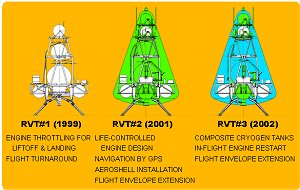 The
three variations of the RVT. (RVT#3 actually flew in 2003.).
The
three variations of the RVT. (RVT#3 actually flew in 2003.).
|
|
How high the
next RVT? Evaluating the value of RVT by ALTITUDE does not make sense.
But for keeping the team active, altitude will be getting higher as long
as RVT evolution is concerned. Next ballistic vehicle should fly above
130km for the reason of application of the vehicle, which means we are
inviting middle altitude atmosphere science community and micro gravity
community into our reusable's circle.
HS:
As I understand from
your response, the RVT#1-3 names refer to different versions of the
same vehicle. The exo-atmospheric ballistic vehicle would not be called
RVT#4 but would have a new name to reflect that it is a whole new
vehicle. Other than being larger, how will the ballistic vehicle design
differ from the RVT? Will it involve any important technology that
you have not tested in RVT#1-3 such as a composite LOX tank?
Inatani:
System studies
are underway. It should have continuous intact safe abort capability.
Since the necessary performance of the 100km-plus vehicle is low,
we can allocate much [of the] weight budget to this abort capability.
Safe return and landing in one-engine-out situation is one of the
typical cases we assume. Though high reliability is of course one
of the important things, it is not all. We are thinking about making
difference between contained and uncontained failure, which means
it is important to detect the signal of failure such as engine-out.
On the subsystem
level, we are studying [an] integrated propulsion and power system
which eliminates toxic fuels, and which make it possible to use only
LOX and LH2 for primary and auxiliary propulsion and power generation.
It will be one of the keys to safe and quick turnaround. I do not
know to what extent [the] integrated system [will be] employed to
the next ballistic vehicle. It depends on the funding and time we
have.
These two new
things will be very important for the "reusable system architecture"
studies to our understanding. Our goal is to do the flight as [in]
aircraft operations. Some other things such as more composite to tanks
and vehicle structures are also in our scope.
HS:
Do
you have funding for [the exo-atmospheric vehicle]? Assuming you do,
when would it begin flying?
|
|
Inatani:
As
stated in [an earlier answer], we are on the year-by-year-funded
basis as basic study. Nothing is determined yet. Again, "decision
maker" problem. We believe we are ready to build ballistic flight
vehicle. RVT campaign will help it greatly.
HS:
Most
development of RLVs in the US is happening in the private sector.
There are about a dozen small companies with significant amounts
of talent and money who are making serious efforts at developing
manned suborbital rocket vehicles. Also, SpaceX in the spring
will launch a satellite on a partially reusable unmanned orbital
vehicle that is completely funded by a private investor.
|
Have
you seen any interest from private companies in Japan in developing
RLVs or in collaborating with your project?
Inatani:
There [is] some interest but just showing their interest, and nothing
happens for the moment. In Japan it is very difficult for private
people to do space or to do flight tests. Big heavy-industry companies
are only looking at the government's money. Rather than these companies,
a company like Toyota or Honda might be a potential mind sharer to
our thoughts and goal.
HS:
One
area where there has been some US government interest is with the
use of suborbital RLVs as observation platforms for remote sensing
and reconnaissance. The company "TGV Rockets", for example, has begun
development of a vehicle aimed primarily at this market. I was wondering
if there has been any interest by Japanese "decision makers" for such
applications of a suborbital vehicle?
For
example, the main target of the satellites lost on the recent H-2A
flight could be monitored also by a suborbital rocket flying routinely
to +100km above southern Japan.
Inatani:
I understand your question, but space and military activities in Japan
are strictly separated.
|
HS:
Will
RVT#4 have any significant payload capability such as for carrying
small scientific experiments?
Inatani:
Our
ballistic vehicle as a next goal should have payload capability.
In our system study, we assume 100kg to 130km in altitude, which
will make science and micro-G experiment possible.
To convince
the community outside rocketry [to] recognize the benefit of reusable
vehicle is one of the key issues, otherwise nobody needs it or
reusable is a sort of selfishness of space community. In order
to do so stepwise, even a small vehicle can stimulate this trait.
It is what we should do NOW. That is why we work with [...] people
outside rocketry.
|
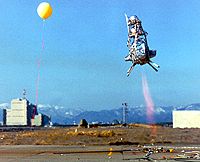
RVT#1
executes a short hop
in 1999. |
|
HS:
Suborbital vehicle projects, such
as those competing for the X PRIZE, have been criticized by many in the
aerospace community as contributing very little to the development of
orbital RLVs. They say the factor of 25 or so greater energy needed to
reach orbit (and to dispose of on reentry) is too great and there is little
overlap in hardware between the two regimes.
In
what ways do you think that suborbital RLV development can contribute
to the development of robust, lower cost orbital RLVs?
|
|
Inatani:
I do not care about X-prize flying machines. Some of them do not
have space flight potential and [are] just an extension of aircraft.
As stated, our study is not for building specific vehicle, but
to study how to design and build the future vehicle. General or
universal things such as aircraft type operation of space vehicle
is the most important thing to my understanding. Again, even a
ballistic vehicle can convince the people [to] recognize the benefit
of reusable vehicles. I admit the direct technical succession
from ballistic to orbital, but what is important is to receive
the understanding of public for the future goals such as tourism
and SSPS. How long do you think it takes? Technically viable things
must be realized when people need it.
|
HS:
In
the early 1990s, Jordin Kare and collaborators at Lawrence Livermore
Labs designed a small SSTO called the Mockingbird. It would only carry
a payload of a kilogram or so but it's sole purpose was to show once
and for all that SSTO RLVs were feasible. The project was approved but,
unfortunately, just as they started development, new management took
over their lab and canceled their funding.
Assuming
[the exo-atmospheric vehicle] is built and is successful, do you believe
you could then build a small demonstration SSTO RLV?
Inatani:
I do not know
Mockingbird. I answer in a different way. Is the rocket SSTO a dream?
madness? When we assume daily flight or very quick turnaround, the vehicles
other than SSTO does not make sense. As far as I know, [only a] vehicle
[capable of] frequent flights [...] can take care of the future demand
[such] as tourism for general public or SPS [Solar Power System] construction.
Only technical guys or those in space community are quarreling on Single-stager
vs. Two-stager issue and rocket vs. air-breathing issues. From viewpoint
of those who invest, it is a childish way of doing thing. Again, technically
viable things must be realized when people need it. We still have many
years before these demands are maturing, and we can expect light-weight
and thermally durable material's progress much more. .
|
HS:
Many
RLV developers in the US have come to believe that LH2 propulsion
is not worth its operational complexities and expense and have
moved to dense non-cryogenic fuels such as kerosene that are easier
to operate with and need smaller tanks. They believe the sacrifice
in propulsion capability is made up by the substantially lower
operational costs. Do you believe, however, that LH2 is essential
for practical orbital RLVs?
Inatani:
For the rocket SSTO, LH2 is absolutely necessary, and no other
choice. Taking a look at energy people and motorcar people, they
are on the way to generalizing use of hydrogen, in other words,
they are going to construct "hydrogen society". [Are] the rocket
guys advancing or behind?
In
addition, looking at recent US works as SLI and its follow-on,
they are [regressing in] my view. They are rolling the history
back to [the 60s], but one of my US friends told me that they
had done much much better in the [60s]. Do not forget we are living
in 21st century .
|
|
HS:
Many
of the people I know in the private RLV development community point
to the 1950's and 60's not for the technology, but for the X project
development style such as with the X-15. The DC-X project, in fact,
was a direct emulation of that style. One study showed that the cost
of the DC-X would have been about 10 times higher if it had been done
with the usual aerospace industry organizational structure.
From
here it looks like the RVT project has also followed an X vehicle
approach by using a small, tightly focused group that worked step-by-step
on a small budget. Do you see advantages with this kind of project
structure? Or is it simply a necessity that you must live with and
you could make much faster progress with lots of money and a big organization?
Inatani:
It is difficult to answer. You pointed out the difference between
a small program and a big one. Following is my understanding. In the
highly matured society and community like US, strict regulation in
safety and in the way of qualification are established already, particularly
in the government program. The "formal" safety and reliability are
required, however what really happens is out of this scope. Substantial
thoughts about these things are essential. This comes from highly
motivated and well-experienced team, and from time to time it is difficult
to establish this kind of GOOD team in [a] big program.
HS:
With
respect to the propulsion system, Mark had a couple questions: a) The
RVT uses what you call "free venting" for the LOX and LH2 tanks. You
say that you have not had any problems with this system, but what precautions
are you taking to keep the gaseous hydrogen from entering into your
airframe??
Inatani:
It was our
concern, too. Free venting means both venting of tanks and [to keep]
out the gases for chilling down engine freely to the outside. These
are guided to the outside by tubing through fuselage. As long as we
did both in the ground firing tests with flight configuration and flight
tests, nothing happened. More than 25 engine firings with free venting
were made. We are monitoring gaseous hydrogen inside the airframe on
the ground before and after the flight and in flight, too. We also have
had to be careful about ground wind. Outside the vehicle, when the hydrogen
damped and engine fired, it slowly burns in a few cases, but no influence
to the vehicle and its flight. No burning occurs in most cases.
HS:
Your fluid schematics show
both the LOX and LH2 tanks as using a dip tube. If the tanks had an
outlet at the bottom, you would be able to use a larger portion of the
fuel in the tanks. Why did you choose to use dip tubes as opposed to
an outlet at the bottom of the tanks?
Inatani:
One of the reasons is to avoid unexpected leakage from valves when it
is in the bottom of each tank. For quick turnaround it is difficult
to check valves in detail on every flight. We took safer location of
valves.
HS:
To build a reliable, low cost fully reusable
orbital vehicle requires a robust high ISP engine. How is your current
testing plan advancing the development of such an engine?
Inatani:
Orbital vehicle is not within our scope for the moment. I admit both
higher performance and higher reliability [are] essential as you point
out. Our current study is aiming at establishing a system architecture
which allows failure [without loss of vehicle] as I stated.
HS:
Thanks very much this interview and the
best of luck with your future projects.
RVT,
The Little Spacecraft That Could - Space Future Journal - May.15.02
A conversation with Carol Pinchefsky at Space Future Journal
Flight Demonstration and a Concept for Readiness of Fully Reusable Rocket
Vehicles
by Yoshifumi Inatani - a reprint of conference article (posted
at Space Future)
More
links to RVT
information, diagrams & photos.
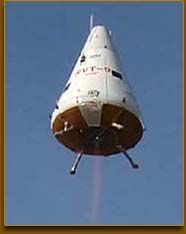
RVT#3 on test series number 9.
Updates:
Jan.20.2004 - Made some corrections and minor syntax modifications
at the request of Prof. Inatani.
|
